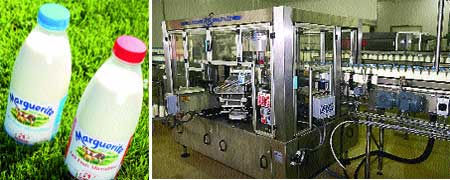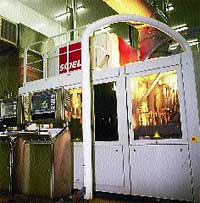PET project fortified by blow/fill/cap
January 29, 2014

For Union des Coopératives Laitières (UCLA), a 134-dairy cooperative nestled in the heart of the Beaujolais region near Lyon, France, taste is a top priority. Letters sent from satisfied consumers all over France evidence this: "I've finally found the natural taste of raw milk," writes a doctor from Alès, in the south of France. Another letter, from a resident of Northern France, reads: "I've been hooked on your wonderful milk ever since I discovered it while vacationing this summer. Where can I find it?"
Proclaiming UCLA's commitment to fresh flavor is its slogan, "Rediscover the Taste," which adorns the panels of the trucks that transport the cooperative's unique dairy product–fresh, microfiltered milk. Collected each night from the cooperative's dairy farms, the fresh milk is taken to UCLA's 5,000-sq-m (54,000-sq-ft) plant in Villefranche-sur-Saône, where it is stored, microfiltered and packaged under the Marguerite label. Within two days of being collected, the milk reaches its point of sale. Relates Phillippe Leseure, assistant director of UCLA, the cooperative's goal is "to become unbeatable in the fresh-milk market."
To accomplish this top-of-market position, UCLA strives for quality at every step–from milking the cows to delivering the product to supermarket shelves. For the small, 32-employee business, this means putting its confidence in modern techniques. Last November, UCLA became the first to package fresh, microfiltered milk in polyethylene terephthalate bottles. To effect this change, the cooperative replaced its Sidel DSL extrusion/blow-molding machine, which had been producing 3,000 high-density polyethylene bottles/hr, with a new line, equipped with Sidel's UltraClean Combi integrated blow/fill/cap system, that has literally doubled UCLA's productivity.
Niche product
In 1932, to better market their product, 300 dairy producers in the region surrounding Lyon organized a cooperative. Milk was collected from surrounding dairy farms and packaged in brick cartons. One million liters were supplied annually, as well as cheeses, butter and other fresh products. As time went on, various farms began to specialize, and production increased. Soon, the cooperative became a Union de Coopératives, with a board of directors.
In 1994, the cooperative took its first technological leap, when it began working on a microfiltration process. During microfiltration, bacteria is removed from raw, whole milk using ceramic filters with 1.4-micron holes. The cream, which is removed and pasteurized, is then reincorporated into the microfiltered milk. Because the procedure does not involve heating the milk, it retains the milk's protein, vitamins and flavor. Microfiltered milk carries a 15-day refrigerated shelf life.
After the cooperative performed the required studies on the process, it requested, and got, the necessary ministerial approvals, and the Marguerite brand was born. For the product launch, the cooperative packaged the microfiltered milk in 1-L HDPE bottles and invested in a line equipped with a Sidel DSL extrusion/blow-molding machine and a Remy filler (part of the Sidel Blowing and Filling branch), which offered output rates of 1,000 and 3,000 bottles/hr, respectively.
|
After bottles are filled and capped, they are conveyed to a rotary labeler, where they receive hot-melt wraparound labels bearing the Marguerite name. |
In 1997, UCLA produced 3 million liters of Marguerite milk. By 2001, the cooperative had increased distribution to more than 7 million liters, 80 percent of which were shipped to large French supermarket centers such as Atac, Auchan, Carrefour, Casino, Intermarché and Leclerc. The balance was sold to catering companies and small regional stores. "We have positioned ourselves in a niche market," notes Leseure. "Microfiltered milk represents less than ten percent of fresh milk consumed in France." This is in a market where only 3 percent of the milk consumed is fresh.
PET: lightweight and safe from bacteria
In 2002, as demand continued to grow for Marguerite milk, the cooperative took its second technological leap and launched PET operations. "The increase in production meant that we had to invest in new equipment," notes Laurent Fournier, technical director. "We quickly started to consider a new packaging line to increase productivity."
Adds Leseure, "Such an investment for a small company like ours represented a real challenge. But we have to continuously improve quality to remain credible with our customers, who are aficionados of genuine, fresh milk."
At the same time, the cooperative was also facing challenges from competitors in terms of volume/price advantage, Leseure notes. So, the team began to consider its options.
"We were convinced that PET was the future," states Leseure. "It has superior oxygen-barrier properties, it's exceptionally strong, and the bottle and cap don't have tiny leaks, so the product remains free from bacterial contamination." He adds that the lighter weight of PET–28 g, compared to 32 g for HDPE–was also environmentally appealing. And, because it can imitate glass bottles, the clear material can produce containers reminiscent of the original glass bottles used to package fresh milk.
Combination system is the answer
Ultimately, the cooperative selected the Combi SRP 6/16, Sidel's integrated blow/fill/cap system for PET bottles. "The technology guarantees safety from bacterial contamination, without involving a chemical disinfecting phase," explains Leseure.
The system is comprised of a six-cavity blow molder, a 16-nozzle Remy filler and a Zalkin eight-head screw-capping machine. The UltraClean system employs a laminar flow within the filling space, so that filling and capping are hygienic. Also protecting product from contamination, filling takes place within a fraction of a second after bottles are blow molded.
|
Blow molding, filling and capping are all performed within the system's enclosure, which allows for a strictly controlled environment. |
During operation, PET preforms from SGT Co. are fed into the system and directed into an oven where they're heated to an appropriate temperature and then fed into the blower. The blow molder receives the preforms and blows them into 1-L bottles that are swiftly transferred to the Remy machine, which fills them with the microfiltered milk. Filled bottles are then sent to the capping station where they are capped with HDPE closures with an inner and outer lip dual-sealing system, supplied by Bericap and another supplier. Blow molding, filling and capping are all accomplished within the Combi's enclosure, which allows for a strictly controlled environment.
Downstream equipment includes a new 10,000-bph Futura label applicator from P.E. Labellers, a six-pack Dimac Star overwrapping machine from Aetna UK, a Cermex palletizer, and a stretch wrapper from an unknown supplier.
Taste and market testing
Switching to PET was not an impulse decision on the part of UCLA. Because the company was so concerned about the flavor of its milk product, it wanted to be sure that the risks of oxidation by UV rays, which cause a "sunlight flavor" in milk, were eliminated.
To detect the changes in flavor and color of sensitive products, like dairy products and fruit juices, Sidel's testing lab for the past two years has been performing comparison tests on various plastic bottle materials, including HDPE, single-layer and multilayer materials, and PET. The company has established a testing protocol and has a panel of about 30 taste-testers who perform tests, as well as engineers who analyze the products. The ultimate goal is to guarantee bottles with superior barrier properties to oxygen and light.
Says Fournier: "In the end, there was no difference in taste [between the HDPE and the PET bottle]."
Finally, the dairy producer's team tested the reaction of consumers in supermarkets to the PET packaging, and found it positive. Leseure adds that consumers "like the idea of a package that reminds them of the original glass bottle."
Since November, 2002, UCLA has used the Combi to produce 1-L bottles of fresh, microfiltered whole milk and skim milk at speeds of 6,000 bph, giving the company a production capacity of 15 million liters of milk per year. Plans for fall, 2003 include the release of a 1.5-L bottle with a new shape that will also run on the Combi.
More information is available:
Extruder, filler, blow/fill/cap system: Sidel, Inc., 678/221-3000. Circle No. 218.
PET preforms: SGT Co., 33 (0)2 40 05 09 37. Circle No. 219.
Screw capper: Ets André Zalkin Et Cie, 01 41 39 03 00. Circle No. 220.
Caps: Bericap GmbH & Co., 49-6139-29 02 0. Circle No. 221.
Labeler: P.E. s.r.l, 39-0376 389311. Circle No. 222.
Overwrapper: Aetna UK, 44 1234 825050. Circle No. 235.
Palletizer: Cermex, Inc., 678/221-3570. Circle No. 236.
About the Author(s)
You May Also Like




